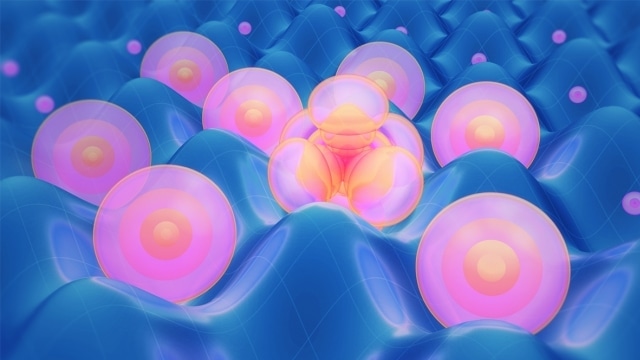Mar 18 2016
The behavior of a few rubidium atoms in a cloud of 40,000 hardly seems important. But a handful of the tiny particles with the wrong energy may cause a cascade of effects that could impact future quantum computers.
 An artist's rendering of a contaminant Rydberg atom in a lattice of rubidium. Credit: S. Kelley/JQI
An artist's rendering of a contaminant Rydberg atom in a lattice of rubidium. Credit: S. Kelley/JQI
Some proposals for quantum devices use Rydberg atoms—atoms with highly excited electrons that roam far from the nucleus—because they interact strongly with each other and offer easy handles for controlling their individual and collective behavior. Rubidium is one of the most popular elements for experimenting with Rydberg physics.
Now, a team of researchers led by JQI Fellows Trey Porto, Steven Rolston and Alexey Gorshkov have discovered an unwanted side effect of trying to manipulate strongly interacting rubidium atoms: When they used lasers to drive some of the atoms into Rydberg states, they excited a much larger fraction than expected. The creation of too many of these high-energy atoms may result from overlooked “contaminant” states and could be problematic for proposals that rely on the controlled manipulation of Rydberg atoms to create quantum computers. The new results were published online March 16 in Physical Review Letters.
“Rydberg atoms interact strongly, which is good for quantum applications,” Porto says. “However, such strong interactions with atoms in the wrong state can impact their usefulness, and our work takes a closer look at this Rydberg physics.”
Playing with atoms
Manipulating atoms is a delicate game. That’s because electrons, bound by their charge to protons in the nucleus, orbit with discrete energy levels determined by quantum physics. Electrons can ascend or descend through these levels as if on an energy ladder, but only when an atom absorbs or emits a packet of light, known as a photon, that is tuned to the energy difference between rungs.
For a single atom, the spacing between energy levels is sharply defined, and photons with slightly different energies—those that don’t quite match the gap between rungs—will excite an atom weakly or not at all. But when many atoms interact, the definite spacing gets smeared out—an example of an effect called broadening. This broadening allows a wider band of energies to excite the atoms, which is precisely the issue that the researchers ran into.
The initial discovery was an accident. “I kept changing the energy and intensity of our lasers, and I just kept seeing the same thing,” says Elizabeth Goldschmidt, a post-doctoral researcher at JQI and the first author of the paper. “You just can’t beat it.”
In an experiment to learn more about this broadening, Goldschmidt and her colleagues began by cooling a cloud of rubidium atoms and trapping them in a 3D grid using interfering beams of light. Then, they used lasers to bathe the entire cloud in photons whose energies could bridge the gap between particular low- and high-energy rungs. Even when varying the laser intensity and the density of atoms over many experiments, the researchers found that they continued to create more Rydberg atoms than expected, an indication that the atomic transition had been broadened.
A possible explanation
The team looked to causes of broadening typically encountered in the lab, such as short-range interactions between atoms or imperfections in laser beams, to explain what they were seeing. But nothing captured the magnitude of the effect.
Although the experiment did not provide direct evidence for the cause, the team suspects that a small fraction of atoms in other Rydberg levels contaminated the excitation process by interacting with clean atoms and broadening their transitions. The first few contaminants, created by stray photons in the environment, led to additional excited atoms and more contaminants, a process that quickly leads to many more excited atoms.
It’s as if the atoms are sampling different shifts to their energy levels because of the changing configuration of these unavoidable contaminants, Goldschmidt says. This causes atoms that wouldn’t otherwise get excited to absorb photons and hop up to the higher energy level, creating more Rydberg atoms.
Such broadening is a challenge for some Rydberg atom-based proposals. Many proposals call for using Rydberg atoms trapped in a lattice to create quantum computers or general purpose quantum simulators that could be programmed to mimic complex physics ordinarily too hard to study in a lab. Rydberg atoms are a favorite platform because they have strong interactions and they don’t need to be right next to each other to interact.
But the broadening discovered here prompts a closer look at these proposals. Some that don’t use Rydberg states directly, but instead use weakly excited Rydberg states to gain some of their advantages and avoid some drawbacks, could also face challenges. “Even with weak lasers that barely excite to the Rydberg state, you still get these contaminants,” Goldschmidt says. “A better understanding of this broadening is important for trying to build Rydberg-based devices for quantum information processing.”